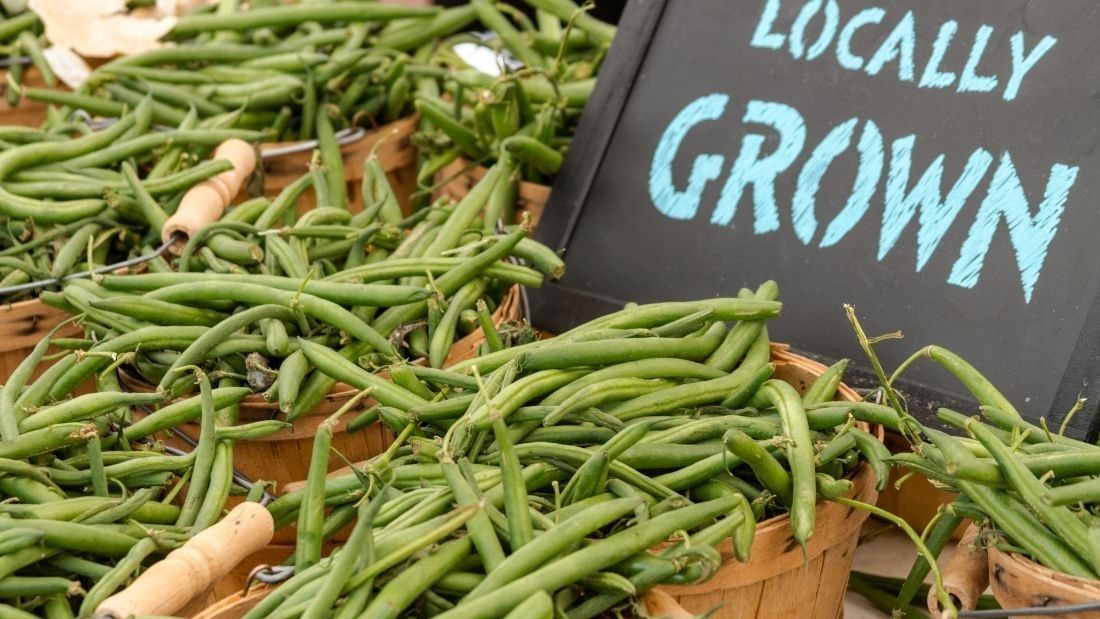Food Miles

The local food movement promotes food produced and grown within a close geographic area. ‘Locavores’ suggest that eating locally produced food provides a way of eating fresh, high-quality foods with a lower environmental impact. However, some of the claims made are simply not true, leading to confusion among consumers. Here we describe how food miles – the distance food travels from farm to plate – relates to a food’s total carbon footprint. We reveal why, contrary to popular belief, what you eat matters far more than where it comes from.
Frequently asked questions
Food miles are the measure of the distance a particular food travels from the farm to your plate. However, transportation makes up a very small amount of the total carbon footprint of food and what you eat is far more important than where your food travelled from.
The carbon footprint of food is a measure of all the greenhouse gases relating to the production of that particular food. It is a better indicator of a food’s environmental impact than just food miles. The carbon footprint takes many factors into account: growing, farming, processing, storing, cooking and disposing of food as well as transport.
The carbon footprint of animal foods, such as meat, fish, dairy and eggs, are considerably higher than those of plant foods (regardless of where they come from), with the largest footprints coming from the meat of ruminants, with beef topping the list. On the other hand, fruit, vegetables, cereals and pulses (including soya) tend to have a much smaller carbon footprint. Producing one kilogram of beef, for example, creates the same amount of greenhouse gas as driving 100 miles in a car, while producing one kilogram of soya beans creates the same as driving less than five miles.
Dr Peter Scarborough, from the University of Oxford, says: “The production of animal-based foods is associated with higher greenhouse gas emissions than plant-based foods.”
The types of food you eat are a major influence on your personal carbon footprint and switching to a vegan diet is the single most effective way to reduce your footprint.
Greenhouse gas emissions (CO2e per kg) from the production of foods in the UK
| Food | kg CO2e per kg |
| Sheep and goat meat | 14.61 |
| Beef | 12.14 to 32.00* |
| Fish (unspecified) | 5.36 |
| Pork | 4.45 |
| Turkey | 3.76 |
| Eggs | 2.94 |
| Chicken | 2.84 |
| Cow’s milk | 1.19 |
| Lentils | 1.06* |
| Avocado | 0.43-0.88* |
| Nuts (miscellaneous) | 0.88* |
| Chick peas | 0.80* |
| Wheat | 0.52 |
| Oats | 0.38 |
| Carrots | 0.35 |
| Apples | 0.32 |
| Peas | 0.29 |
| Potatoes | 0.26 |
| Cabbage | 0.22 |
*imported figures
Source: Audsley et al., 2009.
CO2-equivalents (or CO2-e) is a way of describing the global warming potential of different greenhouse gases in a common unit. The idea is to express the impact of any greenhouse gas in terms of how much carbon dioxide would produce the same amount of global warming.
If you want to eat sustainably then you need to consider more than just food miles. Most of the environmental impact associated with food results from the amount of resources needed to produce it, rather than how far it has travelled. Dr Adrian Williams, of the National Resources Management Centre at Cranfield University, says: “The concept of food miles is unhelpful and stupid. It doesn’t inform about anything except the distance travelled.”
Dr Hannah Ritchie, Senior Researcher and Head of Research at Our World in Data, says that eating local is one of the “most misguided pieces of advice.” For most food products, greenhouse gas emissions from transportation form just a fraction of the total carbon footprint. A better way of assessing the environmental impact of food is to look at its carbon footprint – and plant foods win!
Food miles are not always a good indicator of how environmentally damaging a food is and, in many cases, they may be counterintuitive. Some imported foods may have a lower carbon footprint than their locally grown counterparts. For example, tomatoes imported from hotter countries, where they are grown outside, may have a lower footprint than UK tomatoes grown in heated greenhouses. One study found that lettuces imported from Spain during the winter months, for example, produced three to eight times lower emissions than those grown locally in heated greenhouses.
Another frequently cited example compares lamb produced in England to lamb produced in New Zealand. Most people would expect locally produced lamb to have a lower carbon footprint, but they would be wrong, claims one study. They found that lamb from New Zealand is four times more energy-efficient to produce than lamb from the UK – even including the transport cost. This is because sheep in New Zealand are generally raised on farms run by hydroelectric power. This energy saving is so immense that it overrides the transport fuel output. Of course, plant foods have a much lower impact than lamb and other animal foods, even if they are imported. This shows how misleading food miles can be. If you want to eat sustainably, it’s much simpler to stick to plant foods and to try and buy those that are in season wherever possible.
A vegan diet has a much lower environmental impact than one containing meat and dairy – even if some of the vegan foods are imported and the meat and dairy are produced locally. This is because transport only accounts for a small part of a food’s impact. For beef, for example, transport accounts for just 0.5% of total emissions. Even for avocados, which have a reputation for being environmental hard-hitters, transporting them from Mexico to the UK still only comprises only around 8% of their total carbon footprint.
The reason it’s better to eat vegan than local is because the high levels of greenhouse gases emitted by livestock plus the huge amount of land, water, energy and other resources livestock farming requires. A third of the world’s cereal crop is fed to animals to produce meat, fish, eggs and dairy. This is inefficient, wasteful and unsustainable.
Scientists looking at greenhouse gas emissions associated with food production against food miles found that overall emissions are dominated by the production phase. One study suggested that eating only locally grown food for a year could save the emissions equivalent of driving 1,000 miles, but eating a vegetarian meal on just one day a week for a year could save the equivalent of driving 1,160 miles. So going vegan, for seven days a week, would be a very effective way of lowering your household’s food-related emissions.
Dr Peter Scarborough and colleagues at the University of Oxford looked at the diets of more than 50,000 people in the UK and found that going vegan would halve the greenhouse gas emissions from food – that’s a 50 per cent reduction simply by cutting out animal products. For people eating more than 100 grams of meat a day (equivalent to a small steak or burger), they said, going vegan would reduce their food-related carbon footprint by an impressive 60 per cent, saving the equivalent of 1.5 tonnes of CO2 a year.
This shows how effective just changing your diet can be. The scientific consensus is unequivocal – the most climate-friendly way to eat is to avoid all animal foods and eat a varied vegan diet rich in fruit, vegetables, wholegrains, pulses, nuts and seeds.
Both have been blamed for using up too much water and being transported across vast distances making them less environmentally friendly than other plant foods. Avocado and almond trees do use up more water than many other plants but that’s not the end of the story. They are trees and as such they store carbon and release oxygen, which makes them beneficial for the environment. They also don’t require much processing and their transport happens by boat, not air as some people think. Depending on where you live, you can most likely find almonds and avocados from the same continent – in Europe, both are grown in Spain. If we take all parts of the farm-to-table process into consideration, these plant foods still have a much lower environmental impact than animal foods.
Read more about avocados here.
This duo of South and Central American highly-nutritious foods have been consumed by local populations for millennia. Critics say vegans shouldn’t rely on foods from far away. However, we only use small amounts of both, so one pack goes a long way, and they are transported by sea, which doesn’t have such a high environmental footprint. But most importantly, quinoa and chia seeds are now grown in the UK by the pioneering company Hodmedod. By consuming them, you’re supporting sustainable food production.
Quinoa popularity has led to rising quinoa prices in South America and this resulted in more financial gain for the producers and helped to improve their quality of life. There are also some initiatives to distribute quinoa more widely and ensure that everyone in rural areas has access to it, including making it a part of free school breakfasts.
Chia cultivation requires only low amounts or no fertilisers and doesn’t need too much water, so it’s a very environmentally friendly crop. Also, there are no major pests or diseases affecting chia plants and essential oils in chia leaves have repellent properties against insects making it ideal for organic farming.
Going vegan is the single most effective way to reduce your environmental impact, according to the most comprehensive analysis to date. In a landmark study, researchers Joseph Poore, of the University of Oxford, and Thomas Nemecek, of the Swiss agricultural research institute Agroscope, assessed the environmental impact of different foods. They assessed the impact, from farm to fork, of a huge dataset representing 90% of all food eaten. They looked at greenhouse gas emissions, land use, water use, air pollution (acidification) and water pollution (eutrophication). They found that the environmental impact of meat and dairy products far exceeds that of plant foods. Meat, fish, eggs and dairy, they found, use around 83% of the world’s farmland and contribute 56-58% of food’s greenhouse gas emissions but only provide 18% of the calories we eat.
Moving to a plant-based diet, they said, has transformative potential reducing food’s greenhouse emissions by 49%, land use by 76%, freshwater withdrawals by 19%, acidification by 50% and eutrophication by 49%. For the US, where meat consumption is three times the global average, dietary change has the potential for an even greater effect on food emissions, reducing them by 61-73%. Joseph Poore said: “The reason I started this project was to understand if there were sustainable animal producers out there. But I have stopped consuming animal products over the last four years of this project. These impacts are not necessary to sustain our current way of life. The question is how much can we reduce them and the answer is a lot”.
Gidon Eshel, Assistant Professor in Geophysical Sciences at the University of Chicago says: “…however close you can be to a vegan diet and further from the mean [average] American diet, the better you are for the planet.” No ambiguity there!
Last word
The only truly environmentally-friendly diet, with considerably lower greenhouse gas emissions than that of a meat-eater, fish-eater, or vegetarian, is a vegan diet. Plant foods require less precious water and land than animal foods, they use fewer pesticides and fertiliser. Plant foods are more efficient to produce (you don’t need to feed them plants!), so they go further, feeding considerably more people than meat and dairy foods. If you want to help save the planet, the animals and your health – go vegan.







